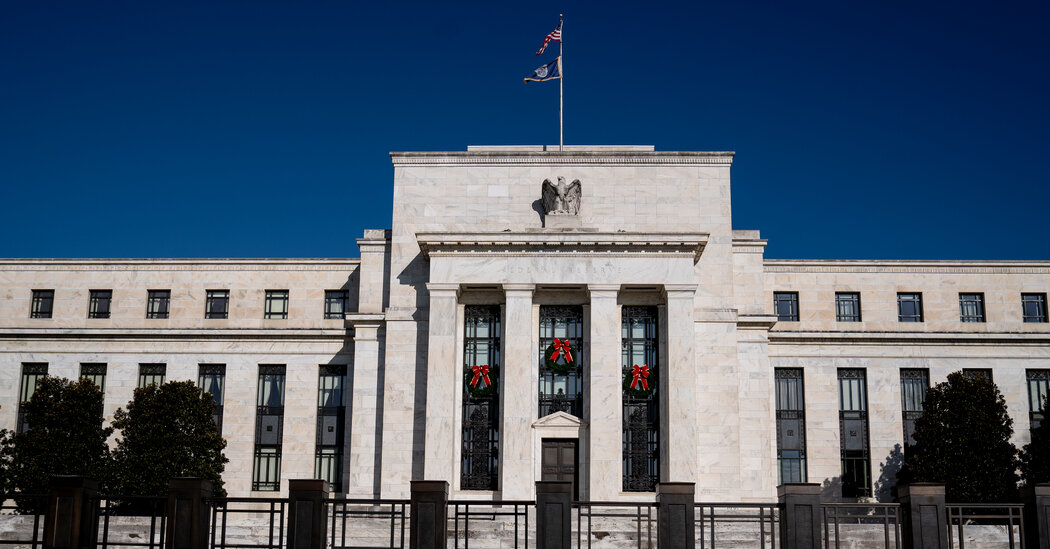
Federal Reserve officials are set to make a second abnormally large interest rate increase this week as they race to cool down an overheating economy. The question for many economists and investors is just how far the central bank will go in its quest to tame inflation.
Central banks around the world have spent recent weeks speeding up their interest rate increases, an approach they’ve referred to as “front-loading.” That group includes the Fed, which raised interest rates by a quarter-point in March, a half-point in May and three-quarters of a point in June, its biggest move since 1994. Policymakers have signaled that another three-quarter-point move is likely on Wednesday.
The quick moves are meant to show that officials are determined to wrestle inflation lower, hoping to convince businesses and families that today’s rapid inflation won’t last. And, by raising interest rates quickly, officials are aiming to swiftly return policy to a setting at which it is no longer adding to economic growth, because goosing the economy makes little sense at a moment when jobs are plentiful and prices are climbing quickly.
But, after Wednesday’s expected move, the Fed’s main policy rate would be right at what policymakers think of as a neutral setting: one that neither helps nor hurts the economy. With rates high enough that they are no longer actively juicing growth, central bankers may feel more comfortable slowing down if they see signs that the economy is beginning to cool. Jerome H. Powell, the Fed chairman, is likely to keep his options open, but economists and analysts will parse every word of his postmeeting news conference on Wednesday for hints at the central bank’s path ahead.
“It feels like 75 is kind of in the books — the interesting thing is the forward guidance,” said Michael Feroli, the chief U.S. economist at J.P. Morgan, explaining that he thinks the key question is what will come next. “It’s easier to slow down going forward, because every move will be a move into tightening territory.”
The Fed’s latest economic projections released in June suggested that officials would raise rates to 3.4 percent by the end of the year, up from around 1.6 percent now. Many economists have interpreted that to mean that the Fed will raise rates by three-quarters of a point this month, half of a point in September, a quarter-point in November and a quarter-point in December. In other words, it hints that a slowdown is coming.
But policy expectations have regularly been upended this year as data surprises officials and inflation proves stubbornly hot. Just this month, investors were speculating that the Fed might make a full percentage-point increase this week, only to simmer down after central bankers and fresh data signaled that a smaller move was more likely.
That changeability is a key reason that the Fed is likely to emphasize that it is closely watching economic data as it determines policy. Its next meeting is nearly two months away, in September, so central bankers will most likely want to keep their options open so that they can react to the evolving economic situation.
“Much as we’d like Mr. Powell to pull back from the Fed’s recent hyper-aggressive tone, it’s probably too early,” Ian Shepherdson, the chief economist at Pantheon Macroeconomics, wrote in a research note ahead of the meeting.
Still, there are some reasons to think that the path the Fed set forward in its projections could play out. While inflation has been running at the fastest pace in more than 40 years, it is likely to slow when July data is released because gasoline prices have come down notably this month.
And, although inflation expectations had shown signs of jumping higher, one key measure eased in early data out this month. Keeping inflation expectations in check is paramount because consumers and companies might change their behavior if they expect quick inflation to last. Workers could ask for higher pay to cover rising costs, companies might continually lift prices to cover climbing wage bills and the problem of rising prices would be perpetuated.
A variety of other metrics of the economy’s strength, from jobless claims to manufacturing measures, point to a slowing business environment. If that cooling continues, it should keep the Fed on track to slow down, said Subadra Rajappa, the head of U.S. rates strategy at Société Générale. While Fed officials want the economy to moderate, they are trying to avoid tipping it into an outright recession.
“When you start to see cracks appear in the unemployment measures, they’re going to have to take a much more cautious approach,” Ms. Rajappa said.
Markets have been quivering in recent days, concerned that central banks around the world will push their war on inflation too far and tank economies in the process. Investors are increasingly betting that the Fed might lower interest rates next year, presumably because they expect the central bank to set off a downturn.
“It is very likely that central banks will hike so quickly that they will overdo it and put their economies into a recession,” said Gennadiy Goldberg, a rates strategist at TD Securities. “That’s what markets are afraid of.”
But signs of slowing growth and easing price pressures remain inconclusive, and price increases are still rapid, which is why the Fed is likely to retain its room to maneuver.
American employers added 372,000 jobs in June, and wages continue to climb strongly. Consumer spending has eased somewhat, but less than expected. While the housing market is slowing, rents continue to pick up in many markets.
Plus, the outlook for inflation is dicey. While gas prices may be slowing for now, risks of a resurgence lie ahead, because, for example, the administration’s efforts to impose a global price cap on Russian oil exports could fall through. Rising rents mean that housing costs could help to keep inflation elevated.
While Mr. Powell made clear at his June news conference that three-quarter-point rate increases were out of the ordinary and that he did “not expect” them to be common, Fed officials have also been clear that they would like to see a string of slowing inflation readings before feeling more confident that price increases are coming under control.
“We at the Fed have to be very deliberate and intentional about continuing on this path of raising our interest rate until we get and see convincing evidence that inflation has turned a corner,” Loretta Mester, the president of the Federal Reserve Bank of Cleveland, said in a Bloomberg interview this month.
The central bank will get a fresh reading on the Personal Consumption Expenditures index — its preferred inflation gauge — on Friday. That data will be for June, and it is expected to show continued rapid inflation both on a headline basis and after volatile food and fuel prices are stripped out. The Employment Cost Index, a wage and benefits measure that the Fed watches closely, will also be released that day and is expected to show compensation climbing quickly.
Given the recent decline in prices at the gas pump, at least two months of slower inflation readings by September are possible — but not guaranteed.
“They cannot prematurely hint that they think victory over inflation is coming,” Mr. Shepherdson of Pantheon wrote.




